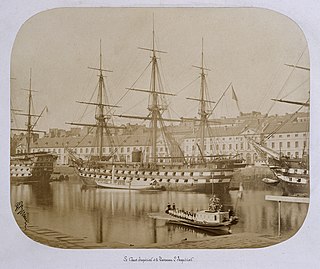
Aigle was a 50-gun ship of the line of the French Navy. Built at Rochefort by P. Morineau between 1748 and 1751, she was launched in 1750. [1]
The ship was wrecked and burnt in the Strait of Belle Isle in 1765. [2]

Aigle was a 50-gun ship of the line of the French Navy. Built at Rochefort by P. Morineau between 1748 and 1751, she was launched in 1750. [1]
The ship was wrecked and burnt in the Strait of Belle Isle in 1765. [2]

HMS Guadeloupe, was a 28-gun sixth-rate Coventry-class frigate of the Royal Navy. The ship was designed by Sir Thomas Slade, and was initially contracted to be built with the Pembrokeshire shipwright John Williams of Neyland; however he became bankrupt and the Admiralty transferred the order to the Plymouth Naval Dockyard.

The Algésiras class consisted of five second-rank, 90-gun, steam-powered ships of the line built for the French Navy in the 1850s. Most of the ships participated in the Second Italian War of Independence in 1859 or the Second French intervention in Mexico in the 1860s. Beginning in the mid-1860s, they were decommissioned or converted into troopships before being scrapped beginning in the early 1870s.

The Ville de Nantes class consisted of three second-rank, 90-gun, steam-powered ships of the line built for the French Navy in the 1850s. Most of the ships participated in the Second French intervention in Mexico in the 1860s and spent extensive amounts of time in reserve. In 1871–1872 the sister ships were used as prison ships after the Paris Commune was crushed by the French government in 1871.

The Téméraire-class ships of the line were a class of a hundred and twenty 74-gun ships of the line ordered between 1782 and 1813 for the French navy or its attached navies in dependent (French-occupied) territories. Although a few of these were cancelled, the type was and remains the most numerous class of capital ship ever built to a single design.
Five ships of the French Navy have carried the name Africaine:
Majestueux was a 110-gun ship of the line of the French Navy, of the Terrible class.

HMS Carnation was a Royal Navy 18-gun Cruizer-class brig-sloop built by Taylor at Bideford and launched in 1807. After the French brig Palinure captured her, she was burned by the French to prevent her recapture.

The Friedland was an 80-gun Bucentaure-class ship of the line of the French Navy, designed by Sané.

Diadème was an 86-gun Bucentaure-class 80-gun ship of the line of the French Navy, designed by Jacques-Noël Sané.

The Neptune was an 80-gun Bucentaure-class 80-gun ship of the line of the French Navy, designed by Sané.

Jupiter was an 80-gun Bucentaure-class ship of the line of the French Navy, designed by Sané.

Charlemagne was an 80-gun French ship of the line. She was laid down in 1850, launched on 16 January 1851 and commissioned on 14 September 1851 before being completed in December.

Mont Saint-Bernard was an 82-gun Téméraire-class ship of the line of the French Navy.
Pandour was a 14-gun brig of the French Navy launched in 1780 as a cutter. The Royal Navy captured her in December 1795 and took her into service as HMS Pandora, but she foundered in June 1797.

The Pégase class was a class of 74-gun ships of the French Navy, built to a common design by naval constructor Antoine Groignard. It comprised six ships, all ordered during 1781 and all named on 13 July 1781.
Twelve vessels of the French Navy have borne the name Auguste :
The Argonaute class was a class of two 74-gun ships of the French Navy, built to a common design by naval constructor François-Guillaume Clairin-Deslauriers. The design was lengthened by 4feet 9½ inches from the designer's previous Scipion class, which had been found to lack stability. The designer died on 10 October 1780, and the construction of these ships was completed by Jean-Denis Chevillard, who was appointed his successor as ingénieur-constructeur en chef at that dockyard in July 1781.

Intrépide was intended to be one of five second-rank, 90-gun, steam-powered Algésiras-class ships of the line built for the French Navy in the 1850s, but her construction was suspended for many years before she was converted into a troopship in 1863. The ship evacuated French troops in 1866–1867 after the defeat of Second French intervention in Mexico. Intrépide became a school ship in 1883 and was renamed Borda in 1890. She was withdrawn from service in 1912 and sank by accident the following year. The ship was scrapped in place from 1913 to 1922.
Five ships of the French Navy have borne the name Africain ("African"):

The action of 24 February 1780 was a minor naval battle that took place off the island of Madeira during the American Revolutionary War. A French convoy was intercepted and pursued by a British Royal Navy squadron ending with the French 64-gun ship Protée being captured along with three transports.